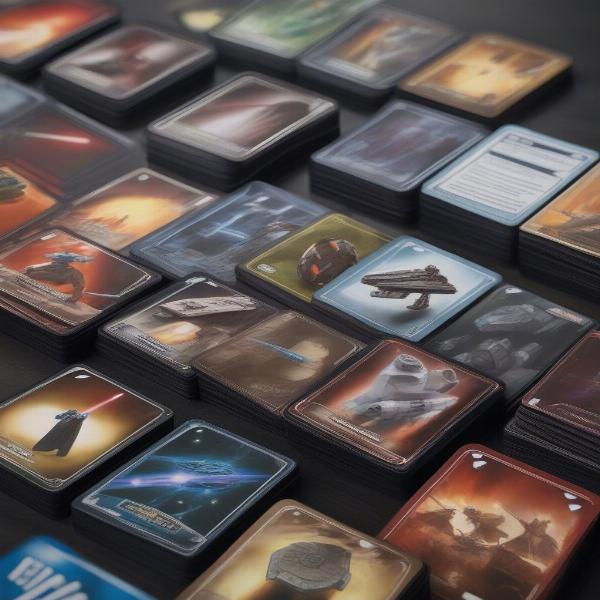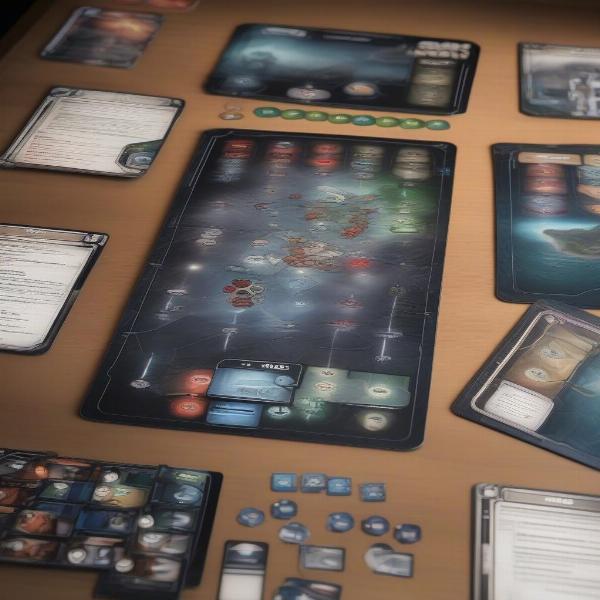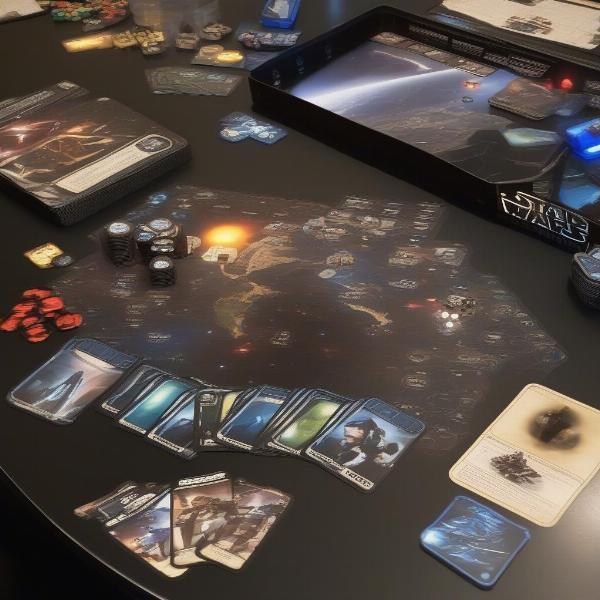Welcome, strategy enthusiasts, to SupremeDuelist.blog, your premier source for all things gaming. Today, we’re diving deep into the heart of a galaxy far, far away with Star Wars: The Deckbuilding Game. This isn’t just another card game; it’s a battle of wits, resources, and iconic characters that puts you at the helm of the Galactic Empire or the Rebel Alliance. Prepare to explore the mechanics, strategies, and meta-game of this engaging card game.
This article will unravel the layers of strategy that make Star Wars: The Deckbuilding Game so compelling. We’ll cover everything from basic card mechanics to advanced tactics that will give you the edge over your opponents. By the end, you’ll have a comprehensive understanding of how to dominate the galaxy. Let’s embark on this adventure and see what makes this deckbuilder a must-have for fans and strategists alike.
Understanding the Core Mechanics of Star Wars: The Deckbuilding Game
At its heart, Star Wars: The Deckbuilding Game is, unsurprisingly, a deckbuilder. You start with a basic deck and gradually acquire more powerful cards throughout the game. Each game sees players vying for control of different locations, with each side starting with their own core set of cards. The core set is what sets the tone for each faction. The Rebel Alliance focuses on gaining support through strong units and hit-and-run tactics, while The Galactic Empire focuses on control and overwhelming firepower.
The Key Components: Cards, Resources, and Locations
The game revolves around three main components: cards, resources (represented by the symbols of “Force”), and locations. Cards are the building blocks of your deck, with different cards providing different effects, like attack power, Force generation, or even special abilities. Resources are used to purchase better cards from a central pool, allowing you to upgrade your deck. Locations are contested by each player, granting points, resources, or special abilities if you control them.
 Star Wars Deckbuilding Game Cards
Star Wars Deckbuilding Game Cards
- Cards: Different types of cards serve different purposes, from basic units to special events. Knowing how and when to use them is crucial.
- Force: Your currency for acquiring new cards. The management and generation of Force is key to building a powerful deck.
- Locations: Contesting locations is essential as it provides key advantages and victory points.
How to Play: A Step-by-Step Guide
- Starting Hand: Players begin with a basic starting deck and draw a starting hand of cards.
- Acquire Phase: Players use their cards to generate resources (Force) and purchase new cards from the central pool or “trade row,” adding them to their discard pile (to later be shuffled into the deck.)
- Combat Phase: Players deploy cards to contested locations, engaging in battles to gain control and score points.
- Clean Up: Discard used cards and draw new ones, preparing for the next round.
This simple yet engaging cycle is what makes the game so accessible and exciting. The tactical choices and card combinations you use will dictate whether you become a master of the Force, or fall to the dark side.
Strategic Depth: Maximizing Your Deck and Actions
Beyond the basic mechanics, Star Wars: The Deckbuilding Game offers a surprising amount of strategic depth. Knowing which cards to acquire, how to manage resources, and when to strike is crucial. Here are some strategies that can help you up your game.
Building a Synergistic Deck
The key to success in Star Wars: The Deckbuilding Game isn’t just about having powerful cards; it’s about having cards that work well together. Look for cards that complement each other, whether it’s by generating extra Force, boosting attack power, or providing special abilities.
“A well-constructed deck is like a well-oiled machine, each part working together to achieve a common goal.” – Master Strategist, Jaxon Reed
- Card Synergies: Identify card combinations that can maximize your output. For example, some cards may generate extra resources if you control certain locations, or grant additional attack power when played with specific types of units.
- Strategic Acquisitions: Don’t just buy the most expensive card available. Focus on cards that fit your overall game plan, and be adaptable to your opponent’s strategy.
- Discard Piles: Manage your discard pile. Understand which cards you will see again, and which you will not, depending on your draw pile. Use cards with strong discard effects wisely.
Location Control and Resource Management
The battle for locations is not just about scoring points, it’s also about controlling key resources and forcing the opponent to react.
- Prioritizing Locations: Evaluate which locations are most beneficial to your strategy, and contest them fiercely.
- Resource Allocation: Balance your resources between acquiring new cards and deploying units to locations.
- Timing your attacks: Don’t immediately engage in combat, it may be more beneficial to prepare your deck first. Sometimes you have to give ground to gain the upper hand.
 Star Wars Game Board Location Control
Star Wars Game Board Location Control
Adapting to Your Opponent’s Strategy
A key aspect of mastering Star Wars: The Deckbuilding Game is adaptability. You can’t just stick to a single strategy; you need to be prepared to react to your opponent’s plays.
- Identify Weaknesses: Look for gaps in your opponent’s deck or strategies that you can exploit.
- Counter Tactics: If your opponent is focused on overwhelming you with units, consider cards that provide area attacks, or neutralize multiple enemy cards at once.
- Flexibility: Be prepared to change your game plan if your initial strategy isn’t working.
The Meta-Game: Understanding Factions and Playstyles
Each faction in Star Wars: The Deckbuilding Game brings a unique flavor and play style to the table, understanding this dynamic is key to truly mastering the game. Whether you choose the brute force of the Galactic Empire, or the cunning of the Rebel Alliance, your success is dependent on understanding the subtleties of each faction.
Galactic Empire: The Power of Control and Aggression
The Galactic Empire favors cards that dominate the board and overwhelm the opponent with powerful units and efficient attacks.
- Control: Cards that disrupt the enemy’s deck and card draws are a key feature of the Empire.
- Aggression: High-power units and efficient attacks to force the pace of the game.
- Resource Advantage: Control of locations allows for generating more resources.
Rebel Alliance: Evasion and Guerrilla Tactics
The Rebel Alliance specializes in sneaky attacks, evading powerful enemies, and bolstering their forces through support and coordination.
- Evasion: Cards that allow them to avoid direct confrontations and strike from the shadows.
- Support: Cards that help to bolster their own units, making them more resilient.
- Hit-and-Run: Taking advantage of opportunities to strike when the enemy is weak.
“The true test of a commander is the ability to adapt and overcome, no matter the challenges.” – Tactician Anya Petrova
Common Questions and Answers
What is the ideal deck size in Star Wars: The Deckbuilding Game?
While there’s no strict “ideal” size, aim for a deck that’s efficient and streamlined. Drawing the right cards when you need them is more important than having a huge deck. Focus on synergy and powerful card combinations.
How important are upgrades in the game?
Upgrades are extremely important. Acquiring better cards provides a huge advantage. Managing your Force to upgrade at the right time is crucial.
Is there a best faction to start with?
Neither faction is inherently “better” than the other. It depends on your play style. The Galactic Empire is a bit more direct and may be easier to start with, but the Rebel Alliance is just as effective in the right hands. Experiment with both.
What should I focus on early in the game?
Early in the game, focus on building a strong base of cards that provide resources, and contest key locations. Don’t waste all your resources on expensive cards in the first few rounds. Look for synergies to be developed.
Are there any beginner-friendly strategies I can try?
For beginners, focusing on resource generation and unit deployment is usually a good start. As you gain more experience, explore more complex strategies like disrupting your opponent’s plans.
 Star Wars Deckbuilding Game Setup
Star Wars Deckbuilding Game Setup
Conclusion: Mastering the Force of Deckbuilding
Star Wars: The Deckbuilding Game is more than just a card game; it’s a strategic journey that takes you to the heart of the Star Wars universe. Its accessibility allows for beginners to grasp the core concepts, while offering enough strategic depth to keep advanced players engaged for hours on end. By understanding the game’s mechanics, developing sound strategies, and adapting to your opponent’s actions, you can become a master of galactic strategy. This game’s ability to recreate the feel of the struggles between the Galactic Empire and Rebel Alliance is what makes it a hit among players of all kinds.
Here at SupremeDuelist.blog, we’re dedicated to bringing you insightful and engaging content about your favorite games. Explore our site for more analysis, reviews, and strategies that will take your gameplay to the next level. Let the Force guide you, and may your deck be ever in your favor. Check out other articles on the site to learn more about the exciting world of deck building games and other strategic board games.
Leave a Reply